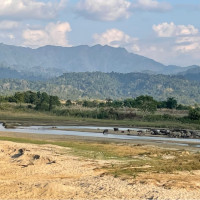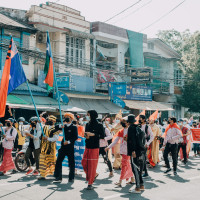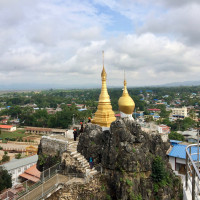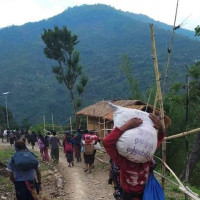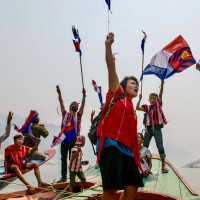The Time for Change in International Aid: The Importance of Civil Society A Myanmar Commentary by Mumyit Sinli Pukdun
Regions
As conflict and military rule continue, Mumyit Sinli Pukdun argues that a major rethink in international aid is essential with a focus on civil society which is at the heart of community resilience and support for national change. Lessons need to be learned from the failed donor policies of the past three decades. Not only has the nature of political challenges been misunderstood but many international agencies have also followed aid policies that have undermined local capacity and organisations. In Myanmar’s latest cycle of state breakdown, support to civil society is vital to address emergency needs and socio-political transformation in the long term.
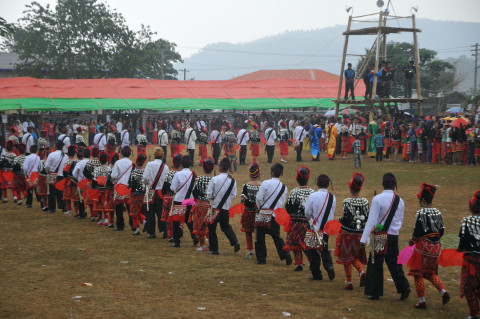
TNI
Recently, a call by an international human rights organisation has been circulating online. Dated August 2015, it states: “Any human rights defender or organisation who is facing risks because of her/his human rights work and needs emergency support may send an application for an emergency grant.” There then follows an email address where applications can be sent.
The statement is clearly out of date. So why is it circulating now? Is it to help promote conversation? Is it a sign of activists facing hardship in their struggles for political change? Or could it be reflection of the sheer numbers of people leaving the country seeking ways to survive? As a new generation of exiles develops, their flight brings back many memories of 1988 when a similar exodus of people took place following the suppression of pro-democracy protests by a previous military regime.
This experience has prompted many discussions, comparing then and now, and I have been talking with older friends and colleagues. Many cannot forget that there were also calls for help during the previous cycle of military rule when there appeared to be international sympathy for the sufferings in our country. Didn’t we make repeated appeals to international organisations for support as our struggle for freedom continued through the 1990s? Sadly, the political crisis in our country is not new.
And this is where many observers feel uneasy. Yes, there was international support during this earlier time. But whether inside the country or around its borders, wasn’t this largely targeted by Western governments and donors at helping the National League for Democracy (NLD), many of whose members had been arrested or gone underground? Over the following years, this saw the emergence of such bodies as the National Coalition Government Union of Burma and Members of Parliament Union which were feted in Western capitals around the world. Certainly, they were in need. They were not, however, the only people suffering and, in many cases, their activities were based abroad.
Into the 21st century, imbalanced – and often paradoxical – aid structures developed as many actors in the West continued to misread the situation. While international attention largely focused on sanctions, Myanmar became an “aid orphan”.1 Humanitarian relief was mostly concentrated on health within the country or refugee camps abroad (mainly along the Thai border), while political support went to the NLD, democracy exiles and movements centred among the Bamar-majority population. In contrast, there was tangibly little support for those that remained inside the country in the front-line of struggle under military rule – most obviously, community-based groups and ethnic nationality organisations, many of which were providing sanctuary to the democracy exiles.
In defence of these decisions, it was often said that there were “no alternatives”, civil society was “dead” or that aid could not be provided in areas that were under the control of ethnic armed organisations (EAOs), whether they were in ceasefires with the military regime or not. But such simplifications failed to understand the trends and dynamics in national politics and society. With strong traditions around cultural and faith-based movements, the 1990s saw the fastest decade of growth in non-governmental groups in Myanmar’s history,2 while a diversity of ethnic nationality movements continued to administer large territories around all the country’s borders. Military rule continued but the spirit and determination of the people remained strong.
Challenges renewed in 2022
What then are the lessons for international engagement in 2022 when, once again, the country is divided by conflict? It is still early days, and it is hoped that mistakes from the past have been learned. But already there are many worries that international donors are repeating the practices and systems from the last time around, failing to understand the nature of our country’s problems and pursuing policies in which their own interests and perspectives are uppermost. If so, the opportunity to reset aid paradigms and bring support to the country’s peoples will be lost. Political impasse and conflict tragedies will continue.
Of course, humanitarian aid is likely to continue for refugees and – where accessible – emergency crises, and that will always be welcome. But concern is spreading that, outside of these “response” definitions, priority will be given to supporters of the National League for Democracy and National Unity Government and that, in order to gain donor support, individuals and organisations must somehow be related within the country or its borders. Regardless of the conflict realities, international focus always seems to be on those who claim “electoral” connections.
Similar concerns exist over the long-standing issue of “conflict resolution”. While international donors are seeking to revive the so-called “peace process” promoted under the NLD-led government, there are worries that mistakes remain unaddressed and that its backers will work again in selective and exclusionary ways that prove divisive and entrench the status quo. In 2022, the conflict landscape is very much changed, bearing comparison with the turmoil and uncertainties after 1988. It is desperate to think that we are back to such times.
Related to this, what about the behaviour of international donors and aid groups themselves? Not all are the same. But haven’t we learnt enough as a consequence of the country opening during the past decade that increased amounts of aid and the in-country presence of foreigners initiating or claiming to represent community programmes has not only threatened but, in some cases, shrunk the space for civil society organisations? Too often, international donor practices are a factor in corrupting civil society values and missions. Prior to 2011, international presence was small.
There is a long list of criticisms: “top-down” approaches; preferring to work through international non-governmental organisations (INGOs) and the UN rather than local civil society organisations (CSOs); relying on foreign “experts” for analysis rather than supporting research and publication by local analysts; international actors setting up their own “local CSOs”; employing indirect cost policies that put the burden on local groups rather than international bureaucracies; undermining sustainability by rejecting core funding (indirect costs) to local CSOs who then are forced to rely on project-based funding; and donor demands for timesheets, payroll allocations and management and financial systems that are impractical to implement in the front-line of struggle. The outcome is very antithetical. Rather than being supported as the driving forces to promote change and develop programmes to improve the quality of lives in their communities, local groups feel that they have been sub-contracted to donor agendas.
On the surface, these may appear as “technical” problems to international actors. However, in a conflict landscape that is highly politicised, they can be very damaging. Not only do they undermine the role of CSOs, but they can also lead to outcomes that contradict the aspirations and interests of local communities. It goes without saying that many of the urgent crises in our country are deeply political and require solutions that reflect the needs and priorities of the people. Reducing notions of aid, therefore, to simply “technical” challenges will not contribute to building peace and democracy which is the long-standing requirement and desire.
Clearly, it is time for a major rethink. Our country is currently passing through one of the greatest times of conflict and instability in its history, and all the issues for better and worse are on the table for examination and investigation. After the aid failures of the past four decades, international donors should also feel the need to soul-search as well. The failings in international aid policies were manifest long before last year’s coup. Aid, they should understand, is never neutral. Focusing support in narrow or self-serving areas while ignoring civil society and the broader challenges in the country at large will have political and humanitarian consequences that could well fuel further breakdown in an already divided land.
What are we standing for?
After an international tour in 1987, the Kachin Independence Organisation (KIO) chairman Brang Seng reflected on his return home that the Kachin cause was little known in the world outside. It was, he said, as if the struggle and sacrifices of the people during the past 26 years had been for nothing after the KIO’s 1961 foundation. Thus, following the events of 1988, he believed that the leaders of the military regime would be quite happy if the KIO stayed in the forests for another quarter of a century while the Myanmar armed forces continued with the politics, business and control of government.
The KIO, Brang Seng was sure, would survive but experience showed that they could not bring change if they continued in the same ways. Therefore, whatever happened in the next cycle of national politics, the KIO had to be on “the inside” if they were to truly represent the aspirations of the people. This thinking in many ways informed the KIO’s subsequent 1994 ceasefire. For the next 17 years, endeavours continued to try and bring about change through negotiation and trust-building until the ceasefire’s 2011 breakdown under attack by the Myanmar military shortly after President Thein Sein took office.3
Although their philosophies and bases for operation are different, CSOs and local NGOs have also taken a broad approach during the past three decades in seeking to be on the inside rather than outside in supporting and representing the people during times of critical change. To sustain peace and political reform, a transformation in society and education are essential. These, they know, cannot be imposed by military or central rule. Thus, in default, there are many movements and community-based groups working to fulfil societal needs amidst division – and in the absence of a functioning state – in the meantime.
Such challenges need a strategic approach. In the Myanmar landscape, some activities can be done openly and in complex situations – and with difficult actors where there is no choice. But in other cases more opaque avenues need to be supported. All should be conflict-sensitive at root. Regardless of international support, CSOs and local NGOs have long been getting on with such actions. By being in the front-line, we recognise our responsibilities to help local communities and bear witness to the realities taking place. Abandonment of the suffering has never been an option.
During the past decade, this vital role played by community-based groups has often been overlooked or downplayed. But this has not deterred their activism nor spread. CSOs have continued to maintain societal space amid humanitarian emergencies with very limited resources – often under multi-military dominance – in different parts of the country. And support for these approaches is still building, aspirations which have gained further ground during the turbulence of the past two years.
Today, despite the many hardships, civil society groups are covering a broad spectrum. As a matter of principle, they see civic space as a necessary condition for furthering democracy and building peace. They have had enough lessons that the country’s dominant institutions won’t change anything while conflict and political impasse continue. The real power, they know, to support change rests with the people whose lives depend on it. They are the only ones who have the right to make the hard choices that are necessary for their survival.
Thus no matter what the internal politics nor international perspectives, civil society in Myanmar is unbound, dynamic and will continue to lay the basis for meaningful change. This is why it needs to be respected and supported if the cycles of military rule and state failure are ever to end.
Can CSOs survive the present crisis and malaise?
Realism is also needed in understanding the capacities of civil society amidst the present breakdown. Many communities are currently watching the greatest land grab and socio-political marginalisation in their history. Such feelings are especially acute among ethnic nationality peoples, and this is exactly what the post-independence generation of Chin, Kachin, Karen, Shan and other nationality leaders were seeking to prevent by negotiation at the British departure in 1948.
Today there is an equation between the ungovernable and inconceivable damage done to our homeland. Sad to say, many leading organisations and institutions in the country, both governmental and non-governmental, left their supporters in limbo during the past decade of mooted “regime change” as they sought opportunity, siding with “business” sectors and ignoring the desperate calls of their followers and parishioners. It also needs to be said that CSOs are not always built upon heroes, although in principle their very reason for existence is to respond to livelihood needs, the disrespect of human rights and humanitarian catastrophes, whether natural or human made. The current environment, however, debilitates the protection and promotion of such values.
In the case of international support, there are steps that can be taken which can boost their output and performance, and this means focusing more closely on the grass-roots rather than stakeholder elites. For example, in terms of internationally-backed projects, few have been community-designed in the past, the task of local CSOs and NGOs being to implement projects decided elsewhere as their offices respond to calls from international initiatives which are often multi-donor in composition. This means that there is no close relationship between local communities and the project.
Equally unhelpful, the commitment of local staff decreases over time since the relation is too small between the needs and deliverables of a project that is invented elsewhere. Field staff, too, may have concerns about contract renewal at the end of an internationally-led project, which are major problems with sustainability and leadership promotion. In essence, if aid practices are to truly change, the culture of donor-driven programmes needs to be brought to an end.
In the meantime, civil society will continue. From my personal point of view as a social worker, I can only urge my colleagues to go “back to basics”. Let us continue to be “part of one whole” and have a sense of common purpose: that is, the protection of human rights, conservation of the environment, support for livelihoods and the promotion of education, social services, culture and the arts. This we can do by facilitating coordination, participatory dialogue and building networks and inclusive platforms. Understanding and opportunity in diverse fields are essential to underpin political reform.
For these activities to be effective, we will need to promote community-led responses to our problems, letting the local peoples design their own projects and deliver them. Like-minded international agencies and individuals may join and support us in these endeavours. But we must all bear in mind that the lack of self-determination and ownership in our country – having no say over the critical issues that affect our lives – are the root causes of many of the problems that we face today. Needless to say, this is not a short-term or stop-gap solution. Experience has long taught that every intervention must be creative enough to bring in the next generation. Our country needs leaders who can see reform through, and the greatest hopes for our future lie in the determination of the young people today.
We cannot afford to lose more time. We cannot count on peace brought about by the Myanmar state. We have seen enough of successive governments, whether military or elected, who have failed to bring peace and reform. And the international peace actors? “Peace” for them seems to be about bringing selected ethnic armed organisations and government leaders (including those of the “hybrid” civilian-military administrations during the past decade) to the table but never considering other basic ground factors nor marginalised peoples in the country at large. Rather than acting as negotiators to bring about justice and inclusion, they have appeared to support the position of the Myanmar government.
The evidence of catastrophe is now disturbing and worsening by the day. Human rights violations and the numbers of displaced persons, refugees and those seeking opportunity in other countries are only growing. And as another generation of young people are denied education and students, especially in ethnic nationality areas, are forbidden to sit for national exams, it is time for a major wake-up call over the divisions deepening within our country and how the international community responds. The politics of isolation and focus on those leaving the country will do little more than send signals of disquiet. In a land riven by conflict, inclusiveness is paramount. Failure to do so will only contribute further to Myanmar’s cycles of conflict.
There are no prescriptive paths to overcome these grave challenges. The struggles for change by the people will continue, and this will be in diverse forms and in different parts of the country. Against this backdrop, there are many ways that aid can be provided, including cross-border and internally on the ground. The failings in past aid policies should be recognised as an integral element in strategy review. And if international aid actors truly seek to help, a major shift towards civil society support, where their interests and needs are prioritised, is an essential step for community resilience and socio-political transformation. This is a struggle over generations, and all the country’s peoples must participate and be engaged.
Mumyit Sinli Pukdun is the pen-name for a social worker and civil society supporter in the aid and humanitarian fields in Myanmar.
Notes
1 For an analysis, see, Mark Duffield, "On the Edge of ‘No Man’s Land’: Chronic Emergency in Myanmar”, School of Sociology, Politics, and International Studies, University of Bristol, Working Paper No.01, 2008.
2 Brian Heidel, The Growth of Civil Society in Myanmar (Bangalore: Books for Change, 2006).
3 At the time, there was little international focus on these endeavours, which reached out into communities across the northeast of the country. Rather, aid perspectives were generally seen through the spectrum of the Thailand border. See, Mandy Sadan (ed.), War and Peace in the Borderlands of Myanmar: The Kachin Ceasefire 1994–2011 (Nordic Institute for Asian Studies, Copenhagen, 2016).
